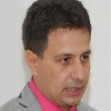
Igor Stojanovic
Work place: Faculty of Computer Science – University “Goce Delcev”, Stip, 2000, R.Macedonia
E-mail: igor.stojanovik@ugd.edu.mk
Website:
Research Interests: Information Storage Systems, Image Processing, Computer systems and computational processes
Biography
Igor Stojanovic earned a M.Sc. degree in 2002 and a Ph.D degree in 2011, both from Ss. Cyril and Methodius University in Skopje. He also received a Ph.D degree in 2014 from University of Nis, Serbia. Currently he is an assistant professor at the Faculty of Computer Science at University “Goce Delcev” - Stip, Macedonia. His research interests are Information Systems, Business Process Modeling, Digital Video and Image Processing.
Author Articles
Classification of Small Sets of Images with Pre-trained Neural Networks
By Biserka Petrovska Igor Stojanovic Tatjana Atanasova-Pacemska
DOI: https://doi.org/10.5815/ijem.2018.04.05, Pub. Date: 8 Jul. 2018
Nowadays the rise of the artificial intelligence is with high speed. Even we are far away from the moment when machines are going to make decisions instead of human beings, the development in some fields of artificial intelligence is astonishing. Deep neural networks are such a filed. They are in a big expansion in a new millennium. Their application is wide: they are used in processing images, video, speech, audio, and text. In the last decade, researches put special attention and resources in the development of special kind of neural networks, convolutional neural networks. These networks have been widely applied to a variety of pattern recognition problems. Convolutional neural networks were trained on millions of images and it is difficult to outperform the accuracies that have been achieved. On the other hand, when we have a small dataset to train the network, there is no success to do it from a scratch. This article exploits the technique of transfer learning for classifying the images of small datasets. It consists fine-tuning of the pre-trained neural network. Here in details is presented the selection of hyper parameters in such networks, in order to maximize the classification accuracy. In the end, the directions have been proposed for the selection of the hyper parameters and of the pre-trained network which can be suitable for transfer learning.
[...] Read more.Model of e-Learning Acceptance and Use for Teaching Staff in Higher Education Institutions
By Mirjana Kocaleva Igor Stojanovic Zoran Zdravev
DOI: https://doi.org/10.5815/ijmecs.2015.04.03, Pub. Date: 8 Apr. 2015
We live in a world where we are exposed to everyday changes that information and communication technologies (ICT) give us impose. These changes are largely related to education, and so the introduction of ICT in universities as institutions of higher education, clearly changing the way it is implemented. The policy of “Goce Delcev” University (UGD) is to fully implement ICT in all segments of management, administration and teaching. For this purpose, several projects for e-learning implementation at UGD have been conducted. But, as much as important introduction is, the more important is the acceptance of new technologies in education. Therefore, we shall use a modified Unified Theory of Acceptance and Use of Technology (UTAUT) as the research methodology. The purpose of this paper is understanding teaching staff acceptance and use e-Learning system (ELC) and investigating the influence of seven determinants (four UTAUT determinants, 2 additional determinants and one personal "self-confidence" determinant). A survey was administered to 92 respondents (teaching staff) to capture their perceptions of e-learning. The findings of this research show that among the seven UTAUT factors, the effort expectancy and facilitating conditions have the strongest effect of intention to use new technology. Also according to the survey, social influence and facilitating conditions are in strongest correlation with the behavioral intention and thereby the most influence on the behavior of participants for acceptance and use of the e – learning system.
[...] Read more.Image Recognition by Using the Progressive Wavelet Correlation
By Igor Stojanovic Aleksandra Mileva Dragana Stojanovic Ivan Kraljevski
DOI: https://doi.org/10.5815/ijigsp.2012.09.01, Pub. Date: 8 Sep. 2012
An algorithm for image recognition and retrieval of image from image collection is developed. Basis of the algorithm is the progressive wavelet correlation. The recognition consists of three incremental steps, each of them quadruples the number of correlation points. The process can be aborted at any stage if the intermediate results indicate that the correlation will not result in a match. The final result is the recognition and retrieval of the required image, if exists in the image collection. Instructions for the choice of correlation threshold value for obtaining desired results are defined. We perform a series of image search experiments that cover the following scenarios: the given image is present in the database; copies of the given image are present but with different names; similar (but not identical) images are present; and the given image is not present. Experiments are performed with data bases up to 1000 images, using the Oracle database and the Matlab component Database Toolbox for operations with databases.
[...] Read more.Other Articles
Subscribe to receive issue release notifications and newsletters from MECS Press journals